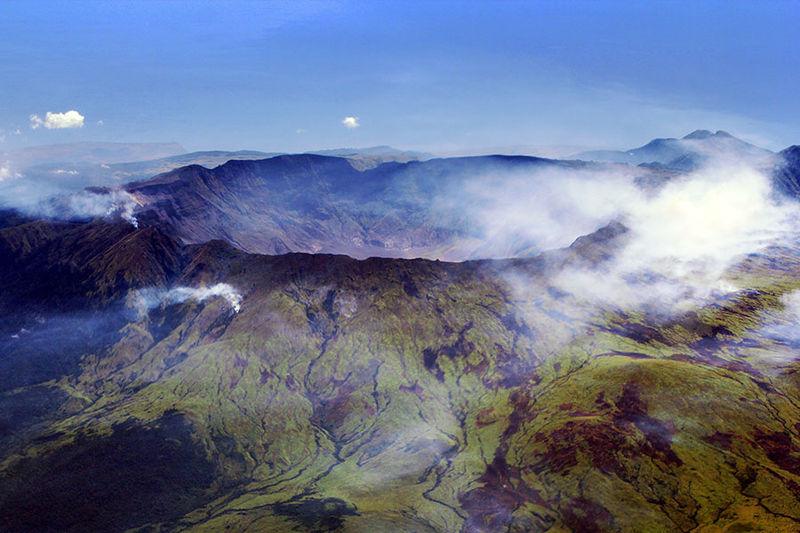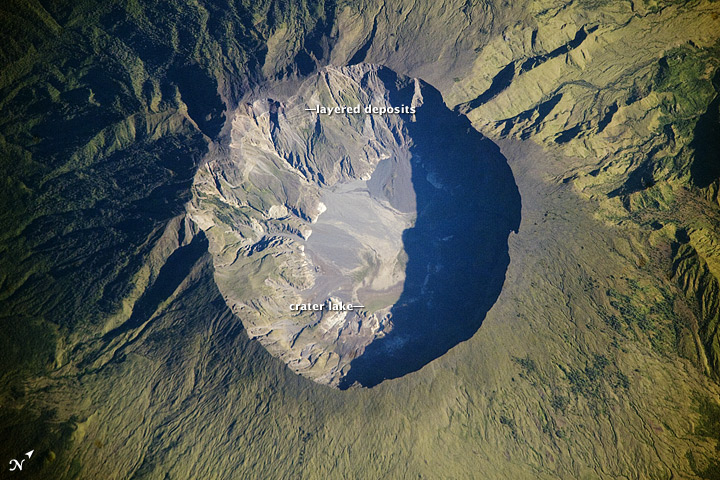199 years ago… the largest eruption in known history and the “Year without a Summer”

In April of 1815 Indonesian Mount Tambora produced the largest and deadliest volcanic eruption on our planet in the known history. A giant plinian eruption column is estimated to have reached about 40 – 50 km altitude.
The volcano unleashed from 50 – 150 cubic kilometers of ash and aerosols into the atmosphere, heavy tephra fall devastated the island of Sumbawa and the surrounding area. Caldera collapse at the end of the eruption destroyed 30 km3 of the mountain and formed a 6 km wide and 1250 m deep caldera. This eruption measured 7 on the Volcanic Explosivity Index scale (VEI), and the effects were felt across the globe for the most of the 19th century.
Rivers of incandescent ash poured down the mountain’s flanks and burned grasslands and forests. The ground shook, sending tsunamis racing across the Java Sea.
Eruption of Mount Tambora coupled with other factors produced global climatic effects and killed more than 100 000 people, directly and indirectly. If we count in the casualties from the new strain of cholera, that originated in the Bay of Bengal as the result of this eruption, indirect casualties climbed up to tens of millions by the end of the century.
Tambora eruption timeline
Scientific experiments have indicated that Tambora had been dormant for 5 000 years but magma had been building up in the chamber.
The first signs of activity took place in 1812 with earthquakes and small eruptions of ash and steam. This continued until April 5, 1815, when the first significant eruption took place sending plume of ash 24 km (15 miles) into the air.
On the evening of April 10, 1815, the eruptions intensified and a massive eruption began to blow the volcano apart. Viewed from a settlement about 24 km to the east, it seemed that three columns of flames shot into the sky.
Volcanic activity continued with pyroclastic flows and ash fallout until April 15th when the final and biggest blast occurred. Toxic gases, rocks, pumice and hot ash rushed across the island and instantly killed over 10 000 people in Tambora province. When this pyroclastic flow hit the water, it generated tsunamis to all the neighbouring islands which caused further deaths and destruction.
The heavy fallout of ash blocked the sunlight for several days on the island of Sumbawa. The volcanic cloud from Tambora was carried to all parts of the world and lowered global temperatures by about three degrees Celsius.
"The year without a Summer" and global effects of Mount Tambora eruption
In 1816 weather patterns in North America, Asia and Europe changed drastically and caused severe droughts, heavy rains, unseasonal floods, famine and epidemics.
While the winter of 1815 – 1816 was fairly ordinary, in the spring of 1816 the temperatures did not rise as expected. Very cold weather persisted in some places well into the summer months. Many places had snow in June and frosty nights in July, August and September.
This unseasonable chill that afflicted much of the Northern Hemisphere in 1816 is now known as the “Year without a Summer.”
The anomaly was probably caused by a combination of a historic low in solar activity (Dalton Minimum, 1790 ~ 1830 ) with a volcanic winter event, caused by a succession of major volcanic eruptions capped by the 1815 eruption of Mount Tambora.
Other large volcanic eruptions (with VEI at least 4) around this time were:
- 1812 – La Soufrière on Saint Vincent in the Caribbean
- 1812 – Awu in the Sangihe Islands, Indonesia
- 1813 – Suwanosejima in the Ryukyu Islands, Japan
- 1814 – Mayon in the Philippines
See the list of all large volcanic eruptions of the 19th century here.
In the spring and summer of 1816, a persistent "dry fog" was observed in parts of the eastern U. S. The fog reddened and dimmed the sunlight, such that sunspots were visible to the naked eye. Neither wind nor rainfall dispersed the "fog".
Cool temperatures and heavy rains resulted in failed harvests in Britain and Ireland. Families in Wales travelled long distances as refugees, begging for food. Famine was prevalent in north and southwestIreland, following the failure of wheat, oats, and potato harvests. The crisis was also very severe In Germany where food prices rose sharply.
Since the telegraph was still being developed news of this major volcanic eruption traveled slowly and it took years for people to connect the dots and begin to understand why this was happening.
A professor of English at the University of Illinois-Urbana-Champaign, Gillen D’Arcy Wood, wrote in a recent article for Slate that the cloud of sulfate gasses slowed the development of the Indian monsoon, the world’s largest weather system, for the following two years.
Drought devastated crop yields across the Indian subcontinent which also experienced unseasonal flooding later. This combination altered the microbial ecology of the Bay of Bengal and gave rise to a new and deadly strain of cholera. This was met with no resistance among the local population, and it spread across Asia and eventually the globe. By century’s end, the death toll from Bengal cholera stood in the tens of millions.
In southwest China, the outlying mountainous province of Yunnan suffered terribly from the cold volcanic weather. In the aftermath of the three-year famine, Yunnan farmers turned to a more reliable cash crop – opium. "Within a few decades, opium was being grown all across Yunnan, while opium-processing technology and expertise drifted south into the remote mountains of modern-day Burma and Laos. The “golden triangle” of international opium production was born."
High levels of tephra in the atmosphere led to unusually spectacular sunsets during this period, a feature celebrated in the paintings of J. M. W. Turner. It has been theorised that it was this that gave rise to the yellow tinge that is predominant in his paintings such as Chichester Canal circa 1828. Similar phenomena were observed after the 1883 eruption of Krakatoa and on the West Coast of the United States following the 1991 eruption of Mount Pinatubo in the Philippines.
The lack of oats to feed horses may have inspired the German inventor Karl Drais to research new ways of horseless transportation, which led to the invention of the draisine or velocipede. This was the ancestor of the modern bicycle and a step toward mechanized personal transport.
The crop failures of the "Year without a Summer" may have helped shape the settling of the "American Heartland", as many thousands of people (particularly farm families who were wiped out by the event) left New England for what is now western and central New York and the Midwest (then the Northwest Territory) in search of a more hospitable climate, richer soil, and better growing conditions.

Mount Tambora, Indonesia. Image acquired March 6, 2009. ISS Crew Earth Observations experiment and Image Science & Analysis Laboratory, Johnson Space Center.
Mount Tambora last appeared in GVP's weekly volcanic report in the week of April 3 – 9, 2013: "Based on visual observations and seismic data, CVGHM raised the Alert Level for Tambora to 2 (on a scale of 1 – 4) on April 5th".
Although there has not been a catastrophic eruption at Mount Tambora since 1815, the volcano is continuously monitored by the Directorate of Vulcanology and Geological Hazard Mitigation, Indonesia.
Featured image: Aerial view of the caldera of Mt Tambora at the island of Sumbawa, Indonesia. Author: Jialiang Gao

Commenting rules and guidelines
We value the thoughts and opinions of our readers and welcome healthy discussions on our website. In order to maintain a respectful and positive community, we ask that all commenters follow these rules:
We reserve the right to remove any comments that violate these rules. By commenting on our website, you agree to abide by these guidelines. Thank you for helping to create a positive and welcoming environment for all.